If you are looking for something extra special for the festive season there is a wide-ranging collection of celebration wear. The bonus is, it can be personalised. Paras Bairoliya, with his design partner Shalini Jaikaria since the last 18 years, has been a regular at trade shows, supplying to the overseas market from the 200 high end stores across India, South East Asia, Middle East, USA, Europe and South Africa. And “loud is out”, says Paras.
“The elegance of beautiful brocades and silks, or just a hand-done Kanni or Pashmina shawl can effortlessly elevate a simple outfit, adding grace to the ensemble,” says Paras. Enhance a simple outfit with a statement jewellery piece, adding subtle glamour to the ensemble. Sophistication with chic hair accessories such as pins or combs are impactful details.
“Delicate embroidery or subtle embellishments in flowy silhouettes and soft tones are in,” says Shalini. Tailor the look to individual preferences, she adds. For NRIs, the duo recommends pastels this season – mints, rose pink, mauves – complemented by accents of gold and silver. Quieter tone-on-tone embellishments, with a touch of controlled bling add a perfect balance for the international clientele.
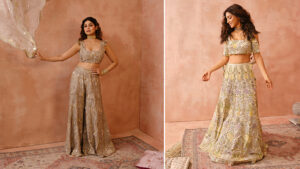
“I feel the tone-on-tone approach and coordinated look are trending. Keeping a cohesive colour scheme, opting for subtle variations within the same colour family ensures a sophisticated look, maintaining a harmonious blend,” says Paras. Tulle, Chantilly laces, and satins with handmade brocades adds a unique charm. Sheer necklines, corset blouses, and a blend of structure and fluidity are popular choices. Full skirts, including mermaid shape, pair seamlessly with well-fitted structured blouses.
Dressing global customers involves navigating the nuances of generational preferences. The older generation often leans towards conventional aesthetics, while the younger generation seeks a modern blend, combining Western influences with traditional elements. There is an East-meets-West fusion. The challenge lies in striking a balance between contemporary and classic styles. “While styling, the focus is on maximising wardrobe versatility. Convertible ensembles like sarees that morph into lehengas or detachable embellishments for mix-and-match options are gaining popularity. Add a cape with the saree for a more exotic look. One can always dress down, and remove the cape – or add one to make it more royal. Cape can also be separately used for styling with any of the modern outfits,” he adds.
With corsets being in fashion, pair it with a skirt or pants for a party. Full skirts can separately be paired with a blouse or crop top for yet another occasion.
Craft revivalism is in, too. The thinking buyer, who aspires to dress sans embroidery, enjoys the luxury of hand-woven textiles, especially Jamdani. The Jamdani has carved a niche among the intellectual crowd, and Nandita Das the filmmaker is a repeat buyer. Tucked away in Kolkata, Paromita Banerjee offers anti-fit blouses, peasant-style frocks, and dresses Canadians, Americans and Europeans with aplomb!
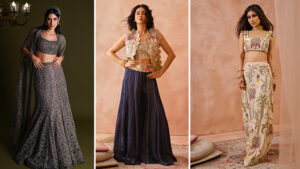
“A saree is a beautiful global contemporary piece of textile, and will always look festive. Black, and jewel tones with touches of antique gold work best. Buyers however prefer fabrics that are easy to wash and maintain,” says Paromita.
One silhouette many looks, is also something she suggests, since most of her global clientele are Indians with a well-travelled vocabulary of dressing. Modern sensibilities with something from their existing wardrobe. “The three-piece set of cape, shirt and palazzo works best when the cape is worn with solid classics for a round-the-year look,” explains Paromita.
“The NRI clientele is very sure of what exactly they want. They are conscious of the money they are spending and want good value for it. Great fit and textile usually wins the deal for us, when they know they will get maximum wear out of it. Along with that is also the intrigue and awe around the textile. They are curious about the intensive processes behind the creation,” she adds.
Most of them shop when they visit India. And they are heavy spenders, when it comes to occasion wear preferring familiar brands. “They look at functionality and climate of wear. Designers know it’s often one-time-wear when it comes to occasions. However, if access is limited, they would want maximum wear out of their purchase. A brand like ours focuses on handwoven textiles which speaks volumes of our making process; the textile stays with you over the years, has great ‘wow’ factor amongst an international audience and sets you apart,” she smiles.
She is now working on a repurposed wedding trousseau. She cites the example of a young lawyer, who wishes to wear her mother’s maroon Tanchoi, sangria Benarasi as a lehenga with a corset-like choli. Studying in Boston and settling in New York, the youngster is a perfect example of someone wanting to stay in touch with her roots but keeping in mind modern aesthetics.
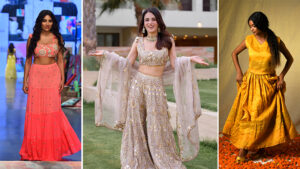
Anju Modi – who has worked with various blockbuster films and has been Sanjay Leela Bhansali’s favourite designer whether it was Ram Leela or Bajirao Mastani, dressing both Ranveer Singh and Deepika Padukone – believes now it is more of universal dressing. “Invest in a beautiful, smart jacket and wear it with cropped pants. Of course, the hues must be bright. I favour reds in different tones — bright reds, deep reds, sindoori reds … they look vivacious, brightens your face. Wine, indigo blues, emerald greens add to the celebratory spirit. Another colour is toosh and it looks good with anything, you can accentuate it with a jewel tone. Handloom fabrics, handmade and breathable, slightly textured, diaphanous tussar silk, blended ones which combine georgette-tussar drape well, mushroo, and velvets have been my constants,” says Anju.
Most overseas shoppers live a fast life, and they want crumple-free clothing. “Easy, no need for ironing, multipurpose use is essential,” she adds.
Designer Anjana Bhargav, a veteran for almost 30 years in the field of fashion believes that the fall of the garment is extremely important. “They also prefer clothes they can wear round the year paired with a seasonal jacket or a wrap, if necessary. Full skirts can be paired with silk shirts, brocade or embroidered trousers can be worn with a long tunic, or with a woollen jacket to make it more versatile,” says Anjana.
Mumbai-based designer Payal Singhal believes that one should consider silhouettes that fuse Indian and Western sensibilities. Play with traditional materials — like for example, a brocade pantsuit or a classic tunic with a low crotch dhoti.
“I don’t think colours can be bracketed based on your geographical locations. While different communities may have specific colour preferences, there is no blanket palette, it’s more a matter of personal taste. We have NRI patrons on both ends of the spectrum — those who love pastels, whites, and crystal work vs those who are more drawn to bright colours and zardozi work,” says Payal.
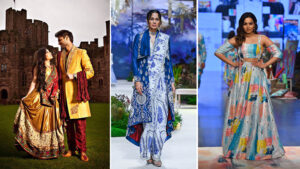
She believes that for people who live overseas lightweight fabrics like georgette, net and organza are ideal. Shaped silhouettes that are easy to wear and to carry to destination weddings, pre-stitched saris, lehengas with attached dupatta, sari gowns or throw-and-go pieces are in. In case of brides, of course, it’s different — they want the whole nine yards. The PS Girls around the world are tied together by the same sensibility no matter where they live. NRI girls are just as aware of Indian fashion as the girls living in India are. With a spurt of online retailers, there is so much awareness about trends and latest styles today. “The USP of the brand since the start has been Indian occasion wear that is global and transcends borders and specific occasions. This is why we have had a strong NRI following since our early days. We understand they don’t use their Indian wear as often, but we help them understand how they can style our clothes in more mainstream ways. Our Indian wear can be split and worn as separates. We also show them ways to style their pieces in more modern, western ways rather than as traditional outfits for non-Indian events,” she adds.

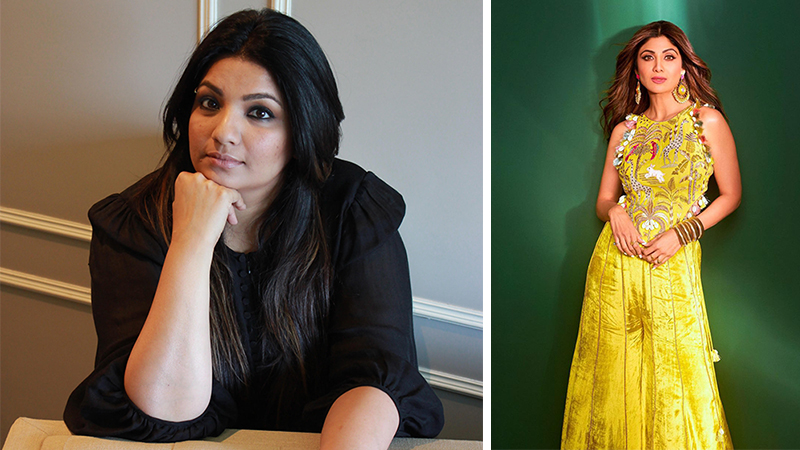
Leave a Reply